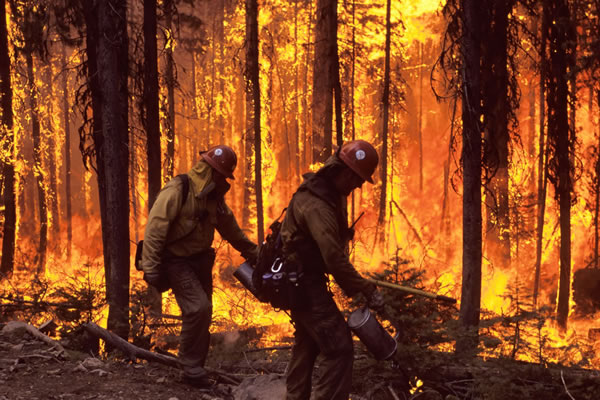How Spectrum Enables Agencies to Fight Wildfires
This is part of a series of blogs highlighting how federal agencies use spectrum to carry out important missions for the American people.
When a large wildland fire breaks out, federal agencies have a number of tools at their disposal, from “smokejumpers” who can parachute into remote areas to airtankers that drop fire retardant from the sky.
But those various tactics would be ineffective – if not outright dangerous – without a communications infrastructure available to firefighting crews. The National Interagency Fire Center (NIFC) and the National Interagency Incident Communications Division (NIICD) are responsible for coordinating communications when federal agencies are managing wildfires.
Portable radios, which require access to radio frequency spectrum, are the primary communications tool for firefighters. As crews respond, Communications Duty Officers at the NIICD work to secure the needed frequencies – in a matter of hours. The NIICD has access to about 50 frequencies as a baseline, and can secure more by working with frequency managers at the Department of Agriculture's Forest Service, the Department of the Interior and the Federal Aviation Administration, as well as federal agency members that make up NTIA’s Interdepartment Radio Advisory Committee and Frequency Assignment Subcommittee.
Some of those baseline frequencies are “clear” – meaning there are no other users – but others are shared by more than one federal agency. Frequency managers must ensure there is no interference as firefighters begin to use a particular frequency.
The NIICD is a partnership between the five federal agencies that are responsible for managing fires on more than 676 million acres of land: the Department of the Interior's Bureau of Land Management, Bureau of Indian Affairs, National Park Service, and U.S. Fish and Wildlife Service, along with the U.S. Forest Service.
In addition to frequency assignments, Communications Duty Officers must coordinate communications equipment and personnel. They also coordinate with state and local officials to ensure interoperability of communications devices.
The scale of the wildland fire challenge is enormous. So far in 2016, there have been more than 31,000 wildfires covering nearly 3 million acres of land. Currently, there are 26 active large fires in 12 states. These fires aren’t bound by borders, so cooperation between local, state and federal agencies is key.
NTIA, which manages federal spectrum use, sees cooperation as a cornerstone of its approach to getting the most out of the nation’s limited spectrum resources. Demand for spectrum is ever increasing – federal agencies are developing more complex wireless systems to better perform critical missions, and industry is using spectrum to fuel a wireless revolution, connecting smartphones, tablets and other devices and objects at faster and faster speeds.
Spectrum sharing is key to this collaboration and is helping to optimize the benefits of spectrum for the public and private sectors. NTIA is committed to working with industry, federal agencies and the Federal Communications Commission to find new spectrum-sharing opportunities. Researchers at NTIA’s Institute for Telecommunication Sciences (ITS) and the Center for Advanced Communications (CAC), a collaborative effort between ITS and the National Institute of Standards and Technology, are experimenting with and testing new sharing paradigms.
Helping to manage and suppress wildfires is just one of the ways federal agencies use spectrum to help carry out vital missions for the American people. Fighting wildfires requires working together under intense pressure. NTIA believes that this same spirit of collaboration can allow these important missions to continue while ensuring that commercial providers have the airwaves they need to innovate and meet the wireless needs of Americans.

